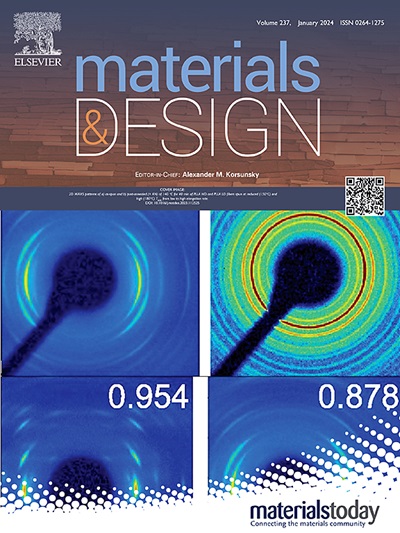Microstructural, mechanical, and thermal characterization of constitutive layers in copper-steel functionally graded material manufactured via laser directed energy deposition
IF 7.6
2区 材料科学
Q1 MATERIALS SCIENCE, MULTIDISCIPLINARY
引用次数: 0
Abstract
Copper-steel functionally graded materials combine the thermal conductivity of copper with the mechanical strength of steel. This study examines the microstructural, mechanical, and thermophysical properties of the constitutive layers of copper-4130 steel functionally graded material fabricated via laser directed energy deposition, considering four intermediate compositions: 100% 4130, 75% 4130 – 25% Cu, 50% 4130 – 50% Cu, and 25% 4130 – 75% Cu. It was observed that the amount of Cu-rich terminal liquid governs crack formation and backfilling during solidification, while Cu-Fe liquid phase separation and Marangoni convection within the melt pool generate macrostructures composed of alternating Cu- and Fe-rich phases. Increasing Cu content progressively enhances thermal diffusivity due to the formation of interconnected copper regions. The application of quenching and tempering treatments induced softening of Cu-containing samples due to Cu recrystallization and diffusion from supersaturated Fe-rich phases. Although solidification cracking was only observed in 75% 4130–25% individual samples, the analysis of a complete multilayer structure revealed that interlayer mixing causes local compositional variations, extending cracking susceptibility beyond this region. These findings provide insights into the key factors governing laser directed energy deposition of copper-steel functionally graded materials, supporting process optimization and predictive model development to enhance manufacturability.

激光定向能沉积制备铜-钢功能梯度材料中本构层的显微结构、力学和热特性
铜-钢功能分级材料结合了铜的导热性和钢的机械强度。本研究考察了通过激光定向能沉积制备的铜-4130钢功能梯度材料本构层的显微组织、力学和热物理性能,考虑了四种中间成分:100% 4130、75% 4130 - 25% Cu、50% 4130 - 50% Cu和25% 4130 - 75% Cu。研究发现,在凝固过程中,富Cu端液的数量决定了裂纹的形成和回填,而Cu- fe液相分离和熔池内的Marangoni对流形成了富Cu和富fe相间的宏观结构。随着铜含量的增加,由于相互连接的铜区域的形成,热扩散系数逐渐增强。淬火和回火处理导致含Cu样品因Cu从过饱和富铁相中再结晶和扩散而软化。虽然凝固裂纹只在75%、130 - 25%的单个样品中观察到,但对完整多层结构的分析表明,层间的混合导致了局部成分的变化,使开裂敏感性超出了这一区域。这些发现为控制激光定向能沉积铜-钢功能梯度材料的关键因素提供了见解,支持工艺优化和预测模型开发,以提高可制造性。
本文章由计算机程序翻译,如有差异,请以英文原文为准。
求助全文
约1分钟内获得全文
求助全文
来源期刊

Materials & Design
Engineering-Mechanical Engineering
CiteScore
14.30
自引率
7.10%
发文量
1028
审稿时长
85 days
期刊介绍:
Materials and Design is a multi-disciplinary journal that publishes original research reports, review articles, and express communications. The journal focuses on studying the structure and properties of inorganic and organic materials, advancements in synthesis, processing, characterization, and testing, the design of materials and engineering systems, and their applications in technology. It aims to bring together various aspects of materials science, engineering, physics, and chemistry.
The journal explores themes ranging from materials to design and aims to reveal the connections between natural and artificial materials, as well as experiment and modeling. Manuscripts submitted to Materials and Design should contain elements of discovery and surprise, as they often contribute new insights into the architecture and function of matter.
 求助内容:
求助内容: 应助结果提醒方式:
应助结果提醒方式:


